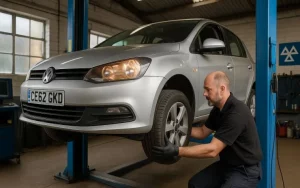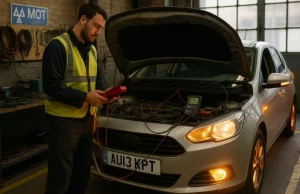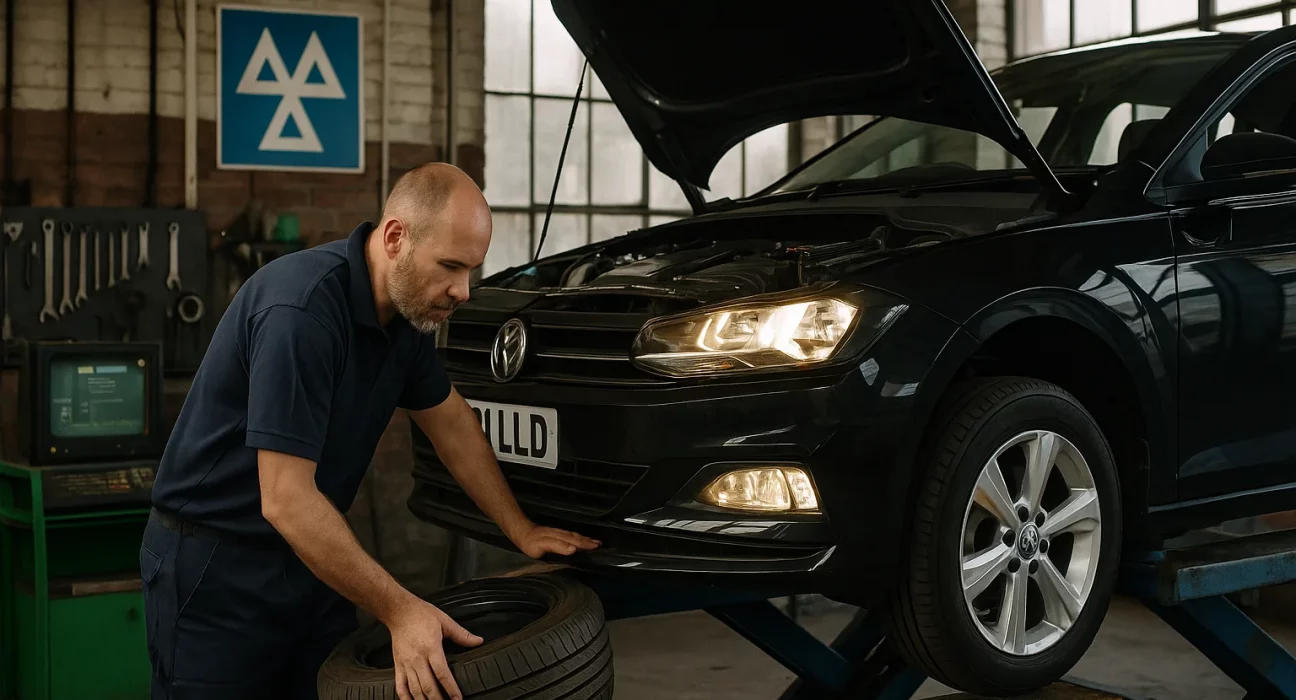Legal roadworthiness is at the heart of safe driving in the UK. Every vehicle on public roads must meet specific mechanical, structural, and environmental standards to protect drivers, passengers, pedestrians, and other road users.
These standards are not optional, they are essential for complying with UK road traffic laws, passing the MOT test, and maintaining valid insurance. From tyres and brakes to lights, emissions, and visibility systems, several components work together to ensure a vehicle is fit for the road.
Understanding how each part contributes to overall roadworthiness helps drivers avoid penalties, reduce accident risks, and maintain a car that performs safely in all conditions.
Which Vehicle Components Affect Legal Roadworthiness in the UK?

Legal roadworthiness means a vehicle meets the safety and environmental standards set out by UK regulations, including the Road Traffic Act and MOT testing requirements.
These rules ensure that essential components function correctly and safely. Any major defect may result in fines, points on a licence, or the vehicle being declared unroadworthy.
Whether a vehicle is privately owned, leased, or part of a fleet, regular checks help maintain compliance. Many factors influence roadworthiness, from mechanical reliability to lighting systems and emissions control, creating a holistic framework drivers must follow.
Why Is Roadworthiness So Important Under UK Law?
Roadworthiness is not merely a technical requirement; it is a legal and moral responsibility. A roadworthy vehicle helps prevent accidents that could injure or even kill individuals on the road.
UK laws mandate that all vehicles must be safe to drive at all times, not just during an MOT test. Failure to maintain roadworthiness can invalidate insurance, lead to prosecution, or result in a dangerous mechanical failure.
Ensuring Public Safety
A well-maintained vehicle reduces risks such as brake failures, blowouts, poor visibility, and loss of control, all common causes of accidents.
Legal Compliance
The Driver and Vehicle Standards Agency (DVSA) oversees enforcement, ensuring that vehicles comply with safety regulations every time they are driven.
Financial Protection
Insurance companies may refuse claims if a vehicle is found to be unroadworthy, placing the financial burden fully on the driver.
How Do Tyres and Wheels Influence a Vehicle’s Legal Safety?
Tyres are one of the most critical components affecting roadworthiness. They directly impact control, braking distance, grip, and handling. UK law requires tyres to meet minimum tread depth standards and remain free from significant damage.
Tyres and Wheels Must Be Compliant With
- Minimum tread depth of 1.6mm across the central three-quarters
- No deep cuts, bulges, or exposed cords
- Correct tyre pressure to maintain handling and braking stability
- Appropriate tyre type and size as recommended by the manufacturer
- Proper wheel alignment and balancing to reduce uneven wear
Faulty tyres can result in a £2,500 fine and three penalty points per tyre, making tyre maintenance a top priority for UK drivers.
What Role Do Brakes and Steering Systems Play in Legal Compliance?
A vehicle’s braking and steering systems are central to road safety. UK regulations require both systems to operate smoothly and effectively, ensuring the driver can maintain full control under all conditions.
Brake System Requirements
Brakes must be responsive, balanced, and free from leakage or corrosion. The braking system includes discs, pads, drums, brake fluid, and hydraulic lines. MOT testers check braking efficiency and overall condition.
Steering System Requirements
The steering system must respond accurately without excessive play. Issues such as worn bearings, faulty steering racks, or low power steering fluid can compromise safety.
Failing Brakes or Steering
Failures in either system significantly increase the risk of collisions. UK enforcement agencies take such failures seriously, often issuing immediate prohibition notices when serious defects are found.
How Do Lights, Indicators, and Electrical Systems Affect Roadworthiness?

Vehicle lighting plays a critical role in visibility and communication. Faulty lights increase accident risks and are a common reason for MOT failures.
Key Lighting and Electrical Requirements Include
- Functional headlights (both dipped and main beam)
- Working brake lights and rear lights
- Operational indicators and hazard lights
- Correct beam alignment for clear road illumination
- Clean and clear lens covers
- Fully functioning number plate lights
Faulty electrical systems affect more than lights, they may impact ABS sensors, ignition systems, or dashboard warnings. Even small electrical issues can escalate into major safety threats if left unresolved.
How Do Mirrors, Windscreens, and Visibility Features Impact Safety?
Clear visibility is vital for safe driving. UK roadworthiness rules require working wipers, unobstructed windscreens, and correctly positioned mirrors.
Windscreen Requirements
Cracks or chips larger than 10mm in the driver’s direct field of vision (Zone A) fail MOT tests. Damage larger than 40mm elsewhere also results in failure.
Mirror Requirements
Vehicles must have at least two functioning mirrors, typically a driver-side mirror plus either a passenger-side or interior rear-view mirror.
Wiper and Washer Requirements
Wipers must clear rain effectively. Washers must provide enough fluid to clean the windscreen during operation. Poor visibility can cause delayed reaction times, making collisions far more likely. Regular checks ensure these components remain compliant.
Why Are Exhaust Systems and Emissions Standards Legally Critical?
The UK places strong emphasis on environmental protection, particularly in urban areas. Exhaust systems and emissions controls ensure vehicles operate cleanly and efficiently.
Emissions and Exhaust Systems Must Comply With
- UK legal emissions limits for CO₂, NOx, and particulates
- Secure and leak-free exhaust systems
- Fully functioning catalytic converters
- AdBlue systems (for diesel) operating without error
- No excessive smoke of any colour (black, blue, or white)
Vehicles emitting unsafe levels of pollutants fail MOT tests and may receive immediate roadworthiness prohibitions. Clean emissions not only protect the environment but enhance overall engine performance.
How Do Seatbelts, Airbags, and Vehicle Structure Support Road Safety?

Safety restraints and vehicle structure are essential for protecting occupants during collisions. These features must function correctly to meet UK safety laws.
Seatbelt Requirements
Seatbelts must latch securely, retract properly, and show no signs of fraying. All seats used by passengers must have appropriate restraints.
Airbag Systems
An illuminated airbag warning light is an automatic MOT failure. Faulty sensors or disconnected modules must be repaired promptly.
Vehicle Structural Integrity
Rust around suspension mounts, seatbelt anchors, or frame components can weaken the vehicle. Structural corrosion is a common MOT failure point.
These components are vital in reducing injury severity and ensuring vehicles meet modern safety expectations.
What Documentation and Maintenance Records Help Prove Roadworthiness?
Roadworthiness is not only about vehicle parts, it also includes proper documentation and evidence of maintenance.
Useful Records Include
- Valid MOT certificate
- Service history and receipts
- Tyre replacement logs
- Brake and fluid change documentation
- Insurance and tax confirmation
Keeping clear records ensures that drivers can demonstrate compliance quickly if needed. Documentation also increases the vehicle’s resale value and builds trust with insurers. Guides from www.londonbusinessinsider.co.uk also emphasise that well-documented maintenance strengthens claims in case of accidents or disputes.
Conclusion
Roadworthiness in the UK is a comprehensive framework that ensures every vehicle meets essential safety and environmental standards. From tyres and brakes to lights, emissions, and safety restraints, each component contributes to a safer driving experience for everyone on the road.
Regular maintenance, proper documentation, and a clear understanding of legal requirements enable drivers to remain compliant and reduce risks. Roadworthiness is not just about passing the MOT, it is about ensuring vehicles perform reliably every day.
By staying attentive to these critical components, drivers demonstrate responsibility, protect themselves from penalties, and play a vital role in maintaining safer roads across the UK.
FAQs
What happens if my vehicle is found unroadworthy?
You may receive fines, penalty points, or a prohibition notice preventing you from driving until repairs are made.
Do all vehicles need an MOT to be roadworthy?
Most vehicles over three years old require an MOT, but even vehicles without MOT requirements must remain legally safe to drive.
Can worn tyres fail an MOT test?
Yes, insufficient tread depth or visible damage results in immediate failure and possible on-the-spot penalties.
Are dashboard warning lights part of roadworthiness checks?
Yes, warning lights such as ABS, airbags, or engine issues must be resolved, as they indicate potential safety risks.
How often should I check roadworthiness components?
Ideally before long journeys and regularly throughout the month to catch issues early and maintain legal compliance.
{
“@context”: “http://schema.org/”,
“@type”: “FAQPage”,
“mainEntity”: [
{
“@type”: “Question”,
“name”: “What happens if my vehicle is found unroadworthy? “,
“acceptedAnswer”: {
“@type”: “Answer”,
“text”: “You may receive fines, penalty points, or a prohibition notice preventing you from driving until repairs are made.”
}
},
{
“@type”: “Question”,
“name”: “Do all vehicles need an MOT to be roadworthy? “,
“acceptedAnswer”: {
“@type”: “Answer”,
“text”: “Most vehicles over three years old require an MOT, but even vehicles without MOT requirements must remain legally safe to drive.”
}
},
{
“@type”: “Question”,
“name”: “Can worn tyres fail an MOT test? “,
“acceptedAnswer”: {
“@type”: “Answer”,
“text”: “Yes, insufficient tread depth or visible damage results in immediate failure and possible on-the-spot penalties.”
}
},
{
“@type”: “Question”,
“name”: “Are dashboard warning lights part of roadworthiness checks? “,
“acceptedAnswer”: {
“@type”: “Answer”,
“text”: “Yes, warning lights such as ABS, airbags, or engine issues must be resolved, as they indicate potential safety risks.”
}
},
{
“@type”: “Question”,
“name”: “How often should I check roadworthiness components? “,
“acceptedAnswer”: {
“@type”: “Answer”,
“text”: “Ideally before long journeys and regularly throughout the month to catch issues early and maintain legal compliance.”
}
}
]
}









Leave feedback about this